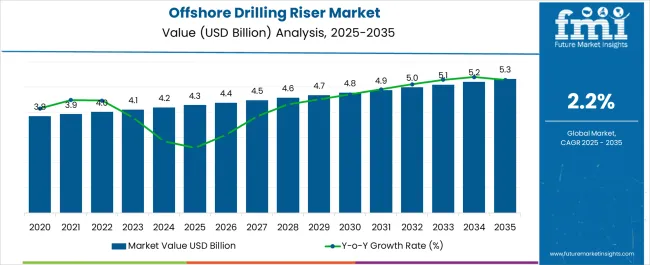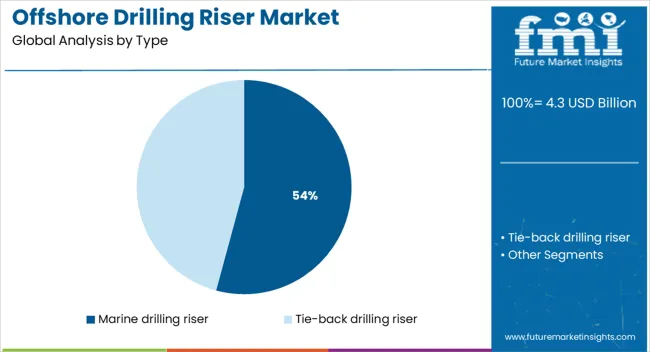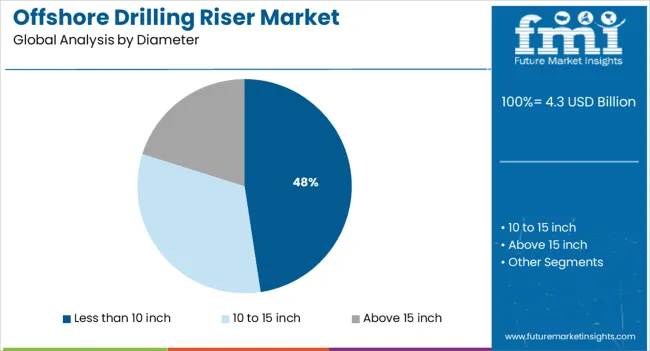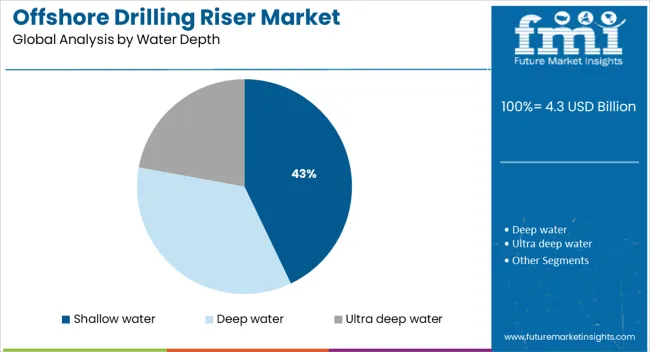The offshore drilling riser market is projected to reach USD 4.3 billion by 2025. The market is projected to reach USD 5.3 billion by 2035 at a compound annual growth rate of 2.2% during the forecast period.

| Metric | Value |
|---|---|
| Offshore Drilling Riser Market Estimated Value in (2025 E) | USD 4.3 billion |
| Offshore Drilling Riser Market Forecast Value in (2035 F) | USD 5.3 billion |
| Forecast CAGR (2025 to 2035) | 2.2% |
The offshore drilling riser market shows steady growth due to rising energy demand. Exploration and production activities continue in offshore basins. Advancements in riser technology and material engineering improve safety, reliability, and cost efficiency.
Regulatory standards raise the focus on safety and environmental protection. Investment flow into deep-water and ultra-deep-water projects supports market expansion. Digital monitoring and predictive maintenance extend equipment life cycles. Shallow-water and deep-water exploration maintain positive outlooks in both established and emerging regions.
The market is segmented by type, diameter, and water depth and region. By type, the market is divided into marine drilling riser and tie-back drilling riser. In terms of diameter, the market is classified into less than 10 inch, 10 to 15 inch, and above 15 inch. Based on water depth, the market is segmented into shallow water, deep water, and ultra deep water. Regionally, the market is classified into North America, Latin America, Western Europe, Eastern Europe, Balkan & Baltic Countries, Russia & Belarus, Central Asia, East Asia, South Asia & Pacific, and the Middle East & Africa.

The marine drilling riser segment holds 54.2% of total revenue in 2025. It connects subsea wellheads to drilling platforms and ensures structural integrity and pressure control. Rising offshore exploration reinforces its use. The segment provides operational stability and minimizes blowout risks. Innovations in design and material durability improve performance under high pressure and corrosive conditions.

The less than 10-inch diameter segment accounts for 47.6% of total revenue in 2025. It fits shallow and mid-depth drilling operations where cost efficiency and operational performance remain critical. Smaller diameters simplify handling, installation, and maintenance. Reduced material requirements improve cost effectiveness.

The shallow water segment is projected to represent 42.90% of overall revenue by 2025 within the water depth category, establishing it as the dominant segment. Growth in this category is supported by the rising number of shallow water exploration projects, which are generally more economical and less complex compared to deep water drilling.
Shallow water environments provide easier accessibility, quicker project turnaround, and lower capital investments, leading to higher adoption of drilling risers in these operations. Additionally, the maturity of shallow water technologies and infrastructure has supported their continued deployment.
As a result, shallow water projects remain a significant contributor to overall market growth in offshore drilling risers.
Offshore drilling riser is a large diameter pipe, which acts as a conduit between the subsea blowout preventer (BOP) stack and the drilling facilities, like rig platform, or submersible rig, located above the seafloor. An offshore drilling riser is often considered as a temporary extension of the wellbore to the surface.
Offshore drilling riser transmits the drilling mud from the well to the rig facility and ensure the drilling fluids do not leak onto the seafloor. Offshore drilling risers, also acts as medium to guide downhole tools like drill string and other drilling tools, allow flow of drilling chemicals, and to carry BOP during run-in or retrieval.
They are also used to run kill and choke lines for BOP, through the outside of riser, along with a number of other axillary lines. Offshore drilling risers can weigh up to 30 tons with a length of 75 ft and range up to 20 inches in outside diameter.
Offshore drilling risers are usually categorized into two different types, marine drilling riser and tie-back drilling riser. Marine drilling risers are deployed from floating drilling vessels and are used with subsea BOP, while the tie-back drilling riser is deployed from fixed drilling platforms with surface BOP.
The operation and design of marine drilling risers are complex and hence incur heavy costs and design analysis, while a tie-back drilling riser is a simplified form of marine drilling riser. The type of offshore drilling riser is chosen based on the complexity of subsea installation systems and water depth.
Recovering crude oil prices have been driving investments in offshore exploration and production (E&P) activities around the world. A significant uptick in the number of final investment decision for a number of offshore projects has been prominent over the past couple of years, which has been driving the contracts for offshore drilling risers.
Emergence of integrated service providers, who provide both design engineering and installation services has been a prominent trend, as they help reduce the overall cost of the project to E&P operators.
Unstable crude oil prices and widening growing crude oil supply-demand gap are anticipated to hamper the growth prospects of the offshore drilling riser market in the foreseeable future.

Advancements in shale gas production, and the growing number of offshore projects in the Gulf of Mexico is anticipated to position North America as the global leader in the offshore drilling riser market.
With the crude oil prices stabilizing, offshore activity in the North Sea region has been witnessing a significant surge, which is expected to drive the demand for offshore drilling riser market in the UK and Norway regions.
Growing number of offshore discoveries in Iran, Nigeria, South Africa, Egypt, Guyana, and Mozambique are expected to create significant growth opportunities for offshore drilling riser manufacturers in the Middle East & Africa region.
Although Latin America is plagues with political and economic instability, the presence of a large number of undeveloped offshore fields is expected to drive the demand for offshore drilling risers in countries like Argentina, Brazil, Mexico and Venezuela.
In Asia Pacific region, China and ASEAN countries are actively exploring offshore projects in the South China Sea region, and hence the region is anticipated to create a robust growth in demand for offshore drilling risers in the coming years.
Some of the key market participants identified in the offshore drilling riser market across the globe are:
The report uses verified industry data and quantitative models. Forecasts rely on established assumptions and validated inputs. Data are segmented by geography, diameter, type, and water depth.
The global offshore drilling riser market is estimated to be valued at USD 4.3 billion in 2025.
The market size for the offshore drilling riser market is projected to reach USD 5.3 billion by 2035.
The offshore drilling riser market is expected to grow at a 2.2% CAGR between 2025 and 2035.
The key product types in offshore drilling riser market are marine drilling riser and tie-back drilling riser.
In terms of diameter, less than 10 inch segment to command 47.6% share in the offshore drilling riser market in 2025.






Full Research Suite comprises of:
Market outlook & trends analysis
Interviews & case studies
Strategic recommendations
Vendor profiles & capabilities analysis
5-year forecasts
8 regions and 60+ country-level data splits
Market segment data splits
12 months of continuous data updates
DELIVERED AS:
PDF EXCEL ONLINE
Offshore Wind Market Forecast and Outlook 2025 to 2035
Offshore Wind Turbine Bearing Market Size and Share Forecast Outlook 2025 to 2035
Offshore Platform Electrification Market Size and Share Forecast Outlook 2025 to 2035
Offshore Crane Market Size and Share Forecast Outlook 2025 to 2035
Offshore Wind Turbine Blade Market Size and Share Forecast Outlook 2025 to 2035
Offshore Wind Turbine Market Size and Share Forecast Outlook 2025 to 2035
Offshore Pipeline Infrastructure Market Size and Share Forecast Outlook 2025 to 2035
Offshore Wind Energy Market Size and Share Forecast Outlook 2025 to 2035
Offshore Structural Analysis Software Market Size and Share Forecast Outlook 2025 to 2035
Offshore ROV Market Growth – Trends & Forecast 2024-2034
Offshore Wind Energy Infrastructure Market
Offshore Equipment Market
Fixed Offshore Wind Energy Market Size and Share Forecast Outlook 2025 to 2035
Export Offshore Wind Cable Market Size and Share Forecast Outlook 2025 to 2035
Floating Offshore Wind Energy Market Size and Share Forecast Outlook 2025 to 2035
Inter Array Offshore Wind Cable Market Size and Share Forecast Outlook 2025 to 2035
Drilling Tools Market Size and Share Forecast Outlook 2025 to 2035
Drilling Type EDM Market Size and Share Forecast Outlook 2025 to 2035
Drilling Machines Market Size and Share Forecast Outlook 2025 to 2035
Drilling and Completion Fluids Market Diapers Market Analysis - Size, Share & Forecast 2025 to 2035

Thank you!
You will receive an email from our Business Development Manager. Please be sure to check your SPAM/JUNK folder too.
Chat With
MaRIA